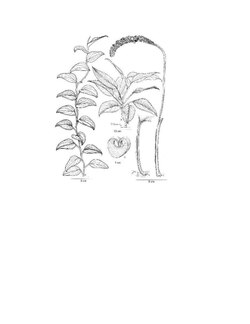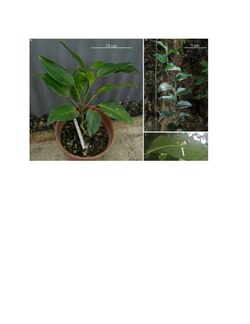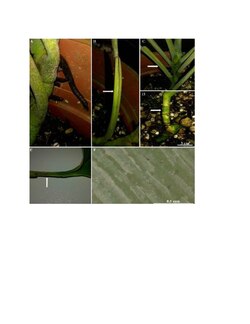Biology:Monstera gambensis
| Monstera gambensis | |
|---|---|

| |
| This picture of a Monstera gambensis shows an adult plant without perforations (A), a juvile with a sheath and wings (C), a cross section of the petiole showing sheath wings (B), and a mature infloresence with cataphylls at the base (E).[1] | |
| Scientific classification | |
| Kingdom: | Plantae |
| Clade: | Tracheophytes |
| Clade: | Angiosperms |
| Clade: | Monocots |
| Order: | Alismatales |
| Family: | Araceae |
| Genus: | Monstera |
| Species: | M. gambensis
|
| Binomial name | |
| Monstera gambensis M.Cedeño & M.A.Blanco
| |
Monstera gambensis is a small species of plant in the family Araceae. It is endemic to the tropical forest of La Gamba, Golfito, Costa Rica where the elevation is 100 m above sea level. They can be found on the floor of the humid forests with their stems climbing up other trees and their aerial roots visible above the soil or even the entire plant growing on other trees. Monstera gambensis is typically not fenestrated until the adult stage, but they can still have at least two perforations on their blade.[1]
Growth


The growth of Monstera gambensis start off as seedlings then grow into juvinile plants with appressed-climbing. The stems are dark green in color with internodes that are only 3-5 cm long, and their petioles are visible being either a dark or light green color, and they have the ability to twist the leaf of the plant to face the sun.[1] The leaf blades are not horizontal nor flat so that the monstera is able to grow on another plant, and they are rarely varigated. Adult Monstera gambensis are still appressed-climbers with dark green stems, similar lengths of internodes and same color of petioles as their juvinile stage, but in this more mature stage, their corky roots have black hairs and the leaf blades are bigger. This is the stage when adult Monstera gambensis can have fenestrations.[1] Monstera gambensis's roots are photosynthetic and can coil on the ground or wrap around a tree. It's roots can also be scattered along the stems that are less compact, giving more room for more roots to grow. And depending on how far the roots are from the host, they will eaither be shorter or longer; the closer to the host, the shorter, and the farther away the longer the roots are.[2] The shape of the Monstera gambensis leaves help it catch the rainwater that falls off of the host plant, and it also gets its neutrients from leaf-litter, which are just leaves on the forest floor that carry the nesessary resources and insulation for Monstera gambensis.[3]
Ecology
Monstera gambensis are hemi-epiphytes, which means that they spend a part of their lifecycle as an epiphyte.[2] Epiphytes spend their lives bring structurally dependent on other trees close by, but what makes the epiphyets "hemi", in this case Monstera gambensis, is that the plant can develop a pseudotrunk that allow them to outgrow their host. This is where the monstera's aerial roots come into play in that they can either go into the soil or spread along the ground.[4] Being an epiphyte is not parasitic even though the monstera has the ability to grow on a host plant, the relationship between a host plant and epiphyte is commensalism, and more specifically facilitation, where the epiphyte is benefited and the host is neither benefited nor harmed, and where the host of the monstera is positivily benefiting the monstera's life.[4]
Reproduction
The pollination of Monstera gambensis typically happens from Trigona pollination, beetle pollination, or fly-pollination. In beetle pollination, the beetles are attracted to the inflorecence on the monstera where they mate and eat the flower or its tissue, or the pollen grains. Similar to the beetle pollination, flies visit the inflorescence on the plant so they can mate and deposit eggs. The adults flies eat the stigmatic secretions or pollen grains, while the larvae eat the decomposing parts of the flower, for example; the stamen after pollen gets dispersed. There is genetic diversity between Monstera gambensis and its family because of these different insect pollination strategies. [5]
References
- ↑ 1.0 1.1 1.2 1.3 1.4 1.5 Cedeño-Fonseca, Marco; Hay, Alistair; Grayum, Michael H.; Blanco, Mario A. (2020-07-01). "Two new endemic species of Monstera (Araceae: Monsteroideae: Monstereae) from Golfito in southern Costa Rica". Webbia 75 (1): 123–132. doi:10.36253/jopt-8091. ISSN 2169-4060. https://oaj.fupress.net/index.php/webbia/article/view/8091.
- ↑ 2.0 2.1 (in English) Air Plants Epiphytes and Aerial Gardens (1st ed.). Sage House, 512 East State Street, Ithaca, New York 14850: Cornell University Press. 2012-06-15. pp. 133–138. ISBN 9780801463877. https://public.ebookcentral.proquest.com/choice/publicfullrecord.aspx?p=3138350&ppg=153.
- ↑ Kocjan, Domen; Dolenc Koce, Jasna; Etl, Florian; Dermastia, Marina (2022-01-27). "Genome Size of Life Forms of Araceae—A New Piece in the C-Value Puzzle" (in en). Plants 11 (3): 334. doi:10.3390/plants11030334. ISSN 2223-7747. PMID 35161315.
- ↑ 4.0 4.1 Zotz, Gerhard; Almeda, Frank; Bautista-Bello, Alma P.; Eskov, Alen; Giraldo-Cañas, Diego; Hammel, Barry; Harrison, Rhett; Köster, Nils et al. (2021-08-01). "Hemiepiphytes revisited". Perspectives in Plant Ecology, Evolution and Systematics 51: 125620. doi:10.1016/j.ppees.2021.125620. ISSN 1433-8319. https://www.sciencedirect.com/science/article/pii/S1433831921000329.
- ↑ Marc, Gibernau; Marion, Chartier; Denis, Barabé (2010). Recent Advances Towards an Evolutionary Comprehension of Araceae Pollination. Denmark: Aarhus University Press, Denmark. pp. 101–114. https://www.researchgate.net/publication/264577133.
Wikidata ☰ Q106908014 entry
 |

